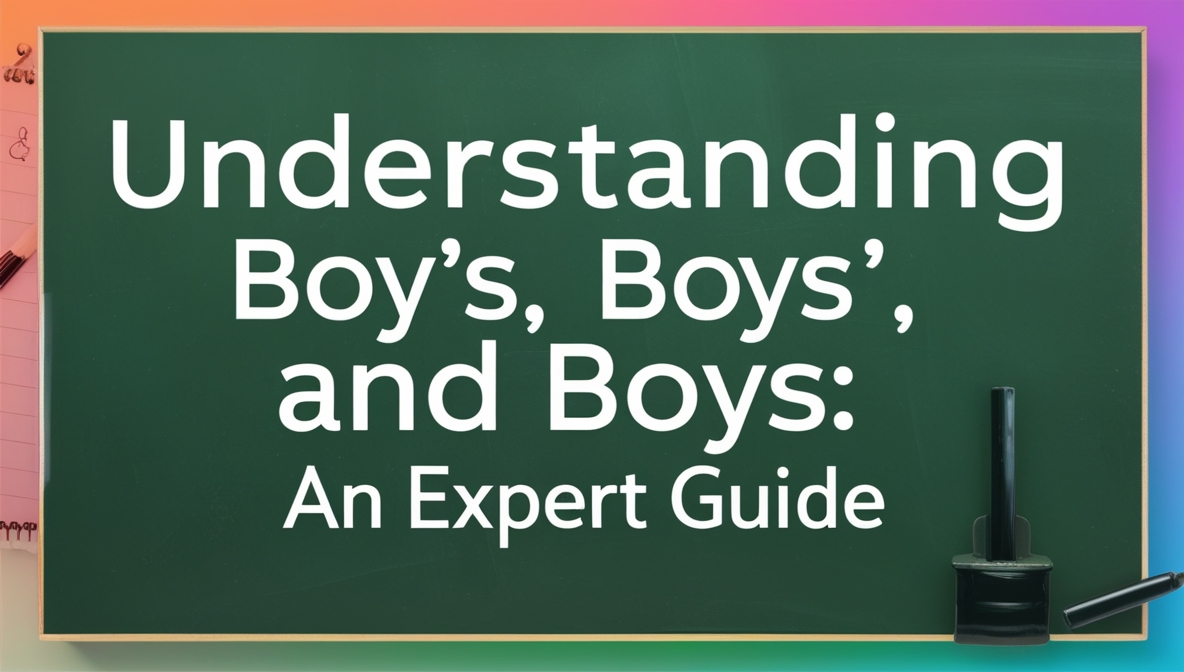The English language is filled with nuances, particularly when it comes to possessive forms. Among the many words that often confuse writers and speakers alike are “boy’s,” “boys’,” and “boys.” Each of these terms has distinct meanings and uses, and understanding them is crucial for clear communication. In this article, we will delve into these three terms, providing definitions, examples, and scenarios to help clarify their differences.
What Does “Boy’s” Mean?
The term “boy’s” is a singular possessive form of the noun “boy.” This means that something belongs to one boy.
Example Scenario
Imagine a young boy named Tommy who loves to play soccer. If you want to refer to his favorite soccer ball, you would say:
- “That is Tommy’s soccer ball.”
In this case, the ball belongs to Tommy, making it a boy’s possession.
Another example could be:
- “The boy’s backpack is on the floor.”
This indicates that the backpack belongs to one specific boy.
What Does “Boys'” Mean?
In contrast, “boys'” is the plural possessive form of “boy.” This indicates that something belongs to more than one boy.
Example Scenario
Imagine a group of boys in a classroom. If you want to talk about their shared project, you could say:
- “The boys’ project was well-researched.”
Here, the project belongs to multiple boys.
Another example might be:
- “The boys’ soccer team won the championship.”
In this instance, the team belongs to a group of boys, hence the use of “boys’.”
What Does “Boys” Mean?
The term “boys” is simply the plural form of “boy,” used to refer to more than one boy without any possessive connotation.
Example Scenario
Consider a playground filled with children. You might say:
- “The boys are playing football.”
In this case, “boys” refers to a group of several boys, with no indication of possession.
Another example could be:
- “The boys in the neighborhood are planning a camping trip.”
This sentence merely indicates the presence of multiple boys without implying that anything belongs to them.
Summary of Differences
To summarize, here are the key distinctions between the three terms:
- Boy’s: Singular possessive (belonging to one boy).
- Boys’: Plural possessive (belonging to multiple boys).
- Boys: Plural noun (referring to multiple boys without possession).
Understanding these distinctions can significantly improve your writing and communication skills. Misusing these terms can lead to confusion and misinterpretation, so it’s essential to use them correctly.
Common Mistakes to Avoid
As with many aspects of the English language, mistakes are common when using these terms. Here are a few common errors and tips on how to avoid them:
1. Incorrectly Using “Boy’s” for Plural Possession
One frequent error is using “boy’s” when referring to something that belongs to multiple boys. For instance:
- Incorrect: “The boy’s shoes are in the hallway.”
- Correct: “The boys’ shoes are in the hallway.”
2. Misunderstanding “Boys” as a Possessive
Another common mistake is to mistakenly assume that “boys” can be used in a possessive context. For example:
- Incorrect: “The boys backpack is new.”
- Correct: “The boys’ backpack is new.”
3. Confusing Context
Context is crucial for understanding which term to use. A sentence like “The boys are going to the park” does not require a possessive form, but if you want to specify something that belongs to them, you must use “boys'”:
- “The boys’ picnic is at the park.”
Practical Tips for Remembering
To help reinforce your understanding, here are some practical tips:
- Visualize Ownership: When you think of “boy’s,” imagine a single boy holding something. For “boys’,” picture a group of boys sharing or owning something together.
- Create Examples: Write down your own examples for each term. The more you practice, the easier it will become to remember their uses.
- Read Aloud: Sometimes, hearing the words can help clarify their meanings. Read sentences containing these terms aloud to see if they sound correct.
Conclusion
In conclusion, mastering the use of “boy’s,” “boys’,” and “boys” is essential for anyone looking to enhance their English language skills. By understanding the distinct meanings and applications of each term, you can avoid common pitfalls and communicate more effectively.
Remember to practice regularly, and don’t hesitate to refer back to this guide whenever you find yourself uncertain. With time and practice, you’ll find that using these terms correctly becomes second nature!

